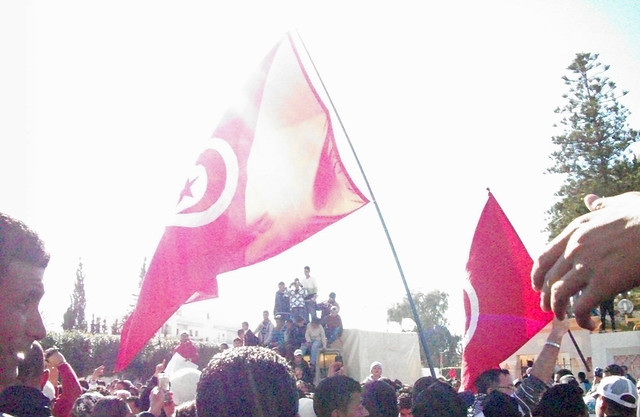SIDI ALI BEN AOUN — Ali Chadli opens his eyes wide, incredulous even now. No, he had no idea his sons were planning to leave for Syria, where they eventually died. "They were praying as usual," he says. "I hadn't noticed anything particular."
The aging man invites us to take a seat next to the grapevine, on the terrace of his little farm, outside a small village called Sidi Ali Ben Aoun. The village sits at the end of a bumpy path lined with olive and barbary fig trees, at the foot of the infamous Sidi Aich mountains, where armed groups have their hideouts, according to villagers.
Located 250 kilometers south of Tunis, this Salafist stronghold is a different world altogether. Here, a portion of the young people dream of jihad in Iraq, Syria or Libya. Some are even starting to turn their anger against their own country.
For Ali Chadli, the troubles began in 2012, with a phone call from Turkey. The voice on the other end was his son Mohammed, who hadn't, the father realized, "gone there for tourism."
Before that, Mohamed attended univeristy and found a job in Tunis as a security guard. He seemed happy and settled, which is why his Ali Chadli was so stunned when his son disappeared to Turkey, the entry door for jihadists heading to Syria. The farmer had no idea that more trouble was yet to come.
A year later, it was his younger son, Raki, who telephoned, days after vanishing. The phone call came from Libya. A second call followed a few weeks later, this time from the Syrian city of Raqqa, the ISIS "capital." Ali Chadli can only speculate about how and why things transpired the way they did. "Maybe he was influenced by his elder brother," he wonders.
The irony of the situation is that the two brothers joined rival organizations: Mohamed fought with al-Nusra, a local al-Qaeda branch, while Raki joined ISIS. That didn't keep them from staying close to one another. It was Raki who called their father when Mohamed was killed in July 2013. Raki himself died in a U.S. airstrike on Raqqa in July 2014. One of Raki's friends called the father to inform him.
Over the past few years, in the small village of Sidi Ali Ben Aoun alone, between 15 and 20 young people are said to have left and gone abroad to fight under the jihadist flag. And the flow continues.
Central Tunisia, left out of the economic development that has mostly benefitted the prosperous coastline, seems to be particularly vulnerable to the jihad temptation. In early July, the country was shocked to learned that some some 30 young adults from the southeastern village of Remada, including three soldiers, had crossed the border with Libya.
Warrior traditions
Tunisia has now become one of the biggest suppliers of jihad candidates around the region. A preliminary report by the United Nations Working Group on the use of mercenaries, published in early July, suggests that some 5,500 Tunisians have left to country to fight, a figure well above the 3,000 that had been officially acknowledged up to that point.
The report pointed out that between 1,000 and 1,500 of them were in Libya. This group of jihadists trained in Libya is particularly worrying here because their main target, it appears, is Tunisia. The attacks in the Bardo Museum on March 18 and at the tourist resort in Sousse on June 26, carried out by perpetrators believed to have been trained in Libya, have highlighted this danger only too well.
To minimize the risk, the Tunisian government decided starting in March to limit the possibility for Tunisians under 35 to travel abroad. Parental permission is now required to visit Libya, Algeria, Morocco and Turkey.
In the city of Sidi Bouzid, where Sidi Ali Ben Aoun's Salafist hotbed is the subject of many conversations, the state's purely security-oriented response inspires general skepticism. The city is considered the cradle of the pro-democracy Arab Spring revolution that began in December 2010 when Mohamed Bouaziz, a young street vendor, set himself on fire to protest government harrassment. Now Sidi Bouzid is brewing with resentment over unfulfilled social and economic promises.
"For disenchanted youths who want to leave, there are two options: illegal emigration or joining ISIS," says Lamine Bouazizi, a left-wing militant.

A file photograph of Sidi Bouzid in 2011. Photo: Magharebia
Taking up arms is made easier given that the region has a strong mujahideen (fighters) tradition. "Whether they were fellaghas, fighting against France, or Arab nationalists who would leave to fight for the Palestinians, this area between Gafsa, Kasserine and Sidi Bouzid has always had a pool of revolutionaries," Lamine Bouazizi explains. "There are legends about them."
The latest in this long line of fighting legends is ISIS. But there's more to the phenomenon than just history and tradition. In the case of Sidi Ali Ben Aoun, there's a sort of taboo, an embarrassing truth that nobody wants to be too vocal about. Those who left for Syria are sending money back home.
Ali Chadli admits he received "little sums" from his sons but insists it wasn't much. Some observers, however, say the influx of money is more significant than locals will admit — enough to expand a family's home, add to its flock of sheep, perhaps fit out the living room with a flatscreen TV. Jihad is about anger and adventure. But it's also about economics.





